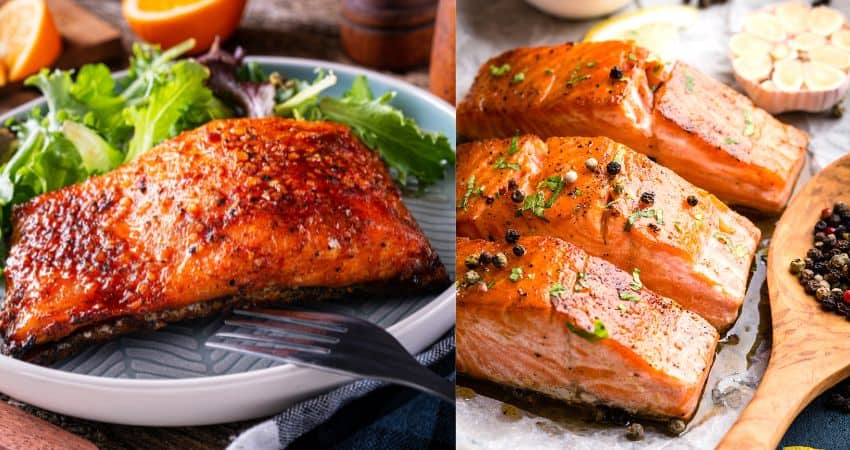Pink vs Red Salmon: What’s The Difference?
There are some big differences between salmon species. Let’s examine the differences between pink and red salmon.
Red salmon is more expensive than pink salmon because of the flavor, color and quantity sold. Pink salmon has a softer texture, milder flavor and it’s lighter working well in salads. Red salmon has a firmer texture and its flavor is more intense than pink. Red salmon works well with other intensely flavored foods.
So, how are red salmon and pink salmon used? I’ll examine that plus a side by side nutrient comparison, differences, mercury levels, taste, texture and costs.
Pink vs Red Salmon Differences

As a Certified Health Coach many clients ask me about food comparisons including salmon. I purchase and consume salmon every week. Therefore, I have researched this topic in the past and present. Let’s examine them closely.
Red salmon is the common name for sockeye salmon while pink salmon represents different kinds of lighter colored salmon. The red salmon flesh color is red while pink salmon is lighter and pinkish. Red salmon weighs about six pounds and spends over a year in freshwater after hatching. Pink salmon weighs about four pounds and goes straight to the ocean after hatching.
Pink and Red Salmon Nutritional Value
If you have the choice between pink or red salmon, which should you get based on nutritional value? To help you answer this, here is all the nutritional information you will need to make that decision.
| Nutrient | Pink Salmon, raw
(4 Ounces) |
Red Salmon, raw
(4 Ounces) |
| Calories | 144 | 149 |
| Fat | 4.9 g | 5.3 g |
| Protein | 23 g | 25 g |
| Omega-3 | 0.70 g | 0.96 g |
| B-6 | 0.69 mg | 0.82 mg |
| B-12 | 4.71 mcg | 5.32 mcg |
| Thiamin | 0.09 mg | 0.15 mg |
| Riboflavin | 0.12 mg | 0.23 mg |
| B5 | 1.16 mg | 1.21 mg |
| Iron | 0.43 mg | 0.49 mg |
| Vitamin A | 39.69 mcg | 55.57 mcg |
| Niacin | 9.06 mg | 9.64 mg |
| Folate | 4.54 mcg | 6.80 mcg |
| Potassium | 415 mg | 416 mg |
| Magnesium | 30 mg | 34 mg |
| Phosphorus | 295 mg | 291 mg |
| Calcium | 7.94 mg | 10.21 mg |
| Zinc | 0.44 mg | 0.52 mg |
| Selenium | 35.6 mcg | 33.8 mcg |
Examining the table above it’s easy to see both fish are full of nutrients1.
Red salmon is better than pink due to its higher number of heart healthy omega-3 fatty acids and B vitamins. Red salmon contains 35% more omega-3s and a higher percentage of B6, B12, B5, thiamin, riboflavin, niacin, folate, vitamin A, calcium and zinc.
Pink salmon is no slouch and offers a great number of nutrients as well2. It just doesn’t have more of a percentage of the nutrient categories like red does. Pink does contain slightly more selenium and has a similar number of phosphorus, magnesium, potassium, protein and iron.
From the nutrient table above, you can make your own inferences about the nutritional values of pink and red salmon. Overall, red salmon has more nutritional value than pink salmon does3. You can eat pink salmon every time and you would be eating healthy too.
For some people it doesn’t really matter which one they eat. Sometimes it comes down to which fish is available or the taste and texture. Which leads me to the next section.
Pink vs Red Salmon: Tastes and Textures
Some people like red salmon more because of its richer flavor and firmer texture. Pink salmon is lighter in flavor and its texture is soft4 . If you are choosing between red and pink salmon, try both out and see what flavors and textures you like better.
If you prefer one over the other, then you should choose that one next time you buy salmon. If you don’t have a preference, then choosing the healthier option (or maybe the cheaper one) could be a great choice for you.
Remember there are ways to cook pink and red salmon to better satisfy your taste buds. Again, red salmon is richer and goes well with other flavorful foods, while pink salmon is more delicate and goes well with lighter foods5.
Depending on your food preferences, you may like one salmon over the other because of how it pairs with your favorite flavors. Both salmon are healthy options, so either one will be a good choice6.
My Poll and Taste Test at Home
I wanted to get the opinion of real people like you and me. Therefore, I wanted to conduct my own research and contacted my clients, readers and members of food groups I belong to. I asked them which salmon they preferred.
- 49% said they preferred the taste of red.
- 41% said they preferred the taste of pink.
- 10% said they had no preference, or it depended on their mood.
I then set up a blind test taste at my home. I prepared both salmons the same way using the same seasonings. Three out of five people, 60% chose the red salmon over the pink. They said the flavor was better.
I wrote another article comparing two types of salmon, keta and sockeye salmon. Check it out here, Keta vs Sockeye Salmon: What’s The Difference?

Pink vs Red Salmon: Substitutions
There are times when you just can’t find the exact fish needed for your planned meal. Whether the supermarket isn’t stocking it today or maybe you already have a type of fish in the refrigerator.
Pink and red salmon can substitute for each other when cooking, although they have slightly different textures and tastes. They both can be cooked using the same methods like slow-roasted, poached, fried or searing in a pan.
When substituting pink salmon for red, certain sauces and ingredients that go well with one should be fine with the other7.
When substituting one fish for another, try to follow these tips:
- Pick similar fillets, whole fillet or cross section.
- Always choose the same weight and size.
- If the recipe calls for skinless, choose skinless and visa versa.
- When grilling a firm texture is more important.
- Substitute a fatty or lean fish for the same.
Pink and Red Salmon Uses
There are many ways to serve pink and red salmon. They pair well with different foods for a variety of dishes and bring great flavors.
Pink salmon can be used like tuna because of its soft texture. Putting it in sandwiches is a great option. It is also smoked, canned and frozen. You can make a variety of meals with salmon with a variety of flavors.
You can make dinner using pink salmon as the main part of your dish. In addition, you can use it as an ingredient to enhance and add flavor.
As mentioned earlier, it has a light flavor so it pairs well with salads and can be put on sandwiches and pizza. Pink salmon is great for creating new meals, and it goes with a variety of foods.

Red salmon is great as a main course. It takes on a smoky flavor very well when it is placed in a smoker for hours. You can also cook it on the stove, grill it and bake it. It pairs well with sweet, sour and creamy flavors like lemon.
Red salmon is used to add richness to the plate. Therefore, you’ll most often see it cooked in a smoker, as a patty or seared in a skillet. The number of recipes and ways to cook red salmon is extensive, so you can search and find a go-to recipe you will love.
There are many ways to eat red and pink salmon. You can decide for yourself if you like lighter flavors or deeper, richer flavors. Use your preference to help decide if you want to eat red or pink salmon.
Then, find recipes online you want to try, and purchase some salmon at your local supermarket or fish market.
Pink vs Red Salmon: Mercury Levels
The Environmental Protection Agency and the Food and Drug Administration have issued warnings regarding mercury levels in fish. They also provide recommendations about how often people should consume them per week8.
They established a list of fish that are best choices, good choices and ones to avoid based on their mercury levels.
Red and pink salmon have similar levels of mercury. Both fish are listed on the FDA’s best choices of fish to consume regarding their mercury levels.
When fish eat other fish in the ocean, more mercury builds up in their bodies over time. Bigger fish have more mercury in them than other smaller fish. Pink and red salmon grow to about the same size which is one reason they’ll contain similar mercury levels.
Always check with a physician prior to eating new foods or changing your dietary habits.
Pink or Red Salmon: Prices
The cost of either salmon will differ depending on your location, supermarket, fresh or frozen and whether it’s farm raised or wild caught.
Red salmon is slightly more expensive than pink salmon. The average cost for red salmon is $19 per pound while the average cost for pink is $17.24 per pound. The cost will vary depending on location, whether it is farm-raised or wild-caught, fresh or frozen.
I visited and checked my local Shoprite, Costco and other supermarkets for the current prices of each.
- Wild Alaskan red salmon
- $20 per pound.
- Wild Alaskan red salmon
- $18 per pound
- Wild Alaskan pink salmon
- $16.50 per pound
- Wild Alaskan pink salmon
- $17.99 per pound
If you have any questions to ask me about this article don’t hesitate to comment below or email us. You can find an email on our contact page.
Read Next – More Salmon vs Fish Articles!
Coho Salmon vs King: What’s The Difference?
Coho Salmon vs Sockeye: What’s The Difference?
Frozen Salmon vs Canned Salmon: Which Is Healthier?
Atlantic vs Pacific Salmon: What’s The Difference?
Sockeye vs King Salmon: A Complete Comparison
- FDA: Seafood Nutrition Facts [↩]
- Nutrition Value: Fish, raw, pink, salmon [↩]
- Nutrition Value: Fish, raw, sockeye, salmon [↩]
- FishChoice: Pink Salmon [↩]
- Alaska Department of Fish and Game: Pink Salmon [↩]
- Pure Alaska Salmon Co: Red Salmon Versus Pink Salmon Versus Tuna [↩]
- Sea Grant North Carolina: Fish Flavors and Substitutions [↩]
- FDA: Advice about Eating Fish [↩]
